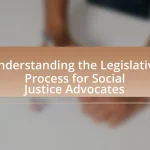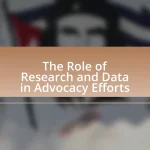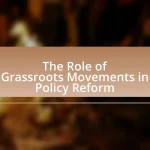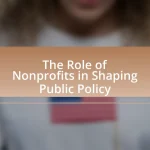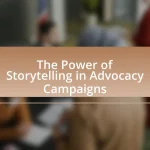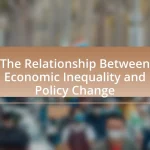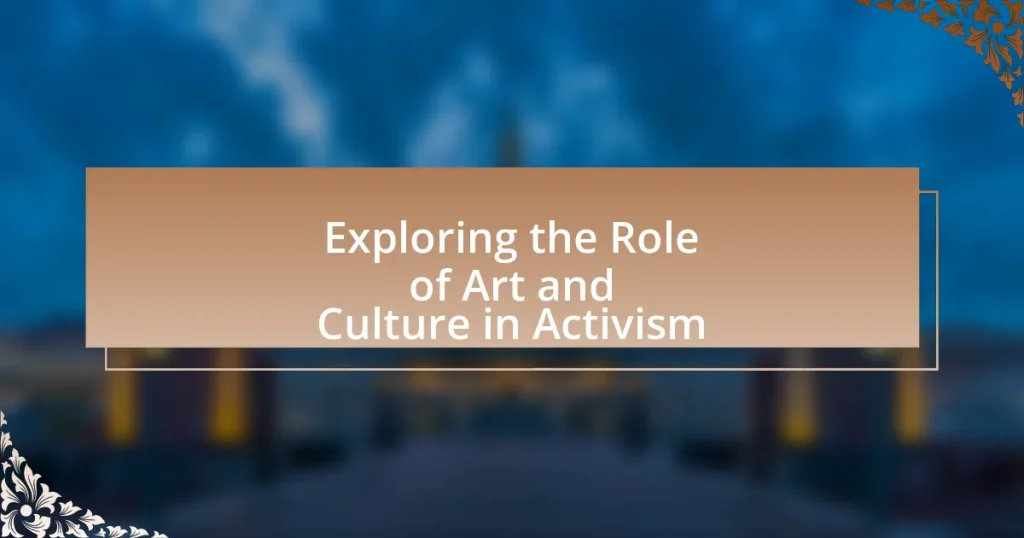The article explores the significant role of art and culture in activism, highlighting how these mediums serve as powerful tools for expression, communication, and mobilization. It examines historical examples, such as the Civil Rights Movement and the Harlem Renaissance, to illustrate the intersection of artistic expression and social movements. The discussion includes various forms of artistic expression, including visual arts, music, literature, and performance art, and their impact on raising awareness and inspiring collective action. Additionally, the article addresses the challenges artists face in activist movements and the future trends shaping the landscape of art in activism, particularly the influence of technology and youth-led movements.
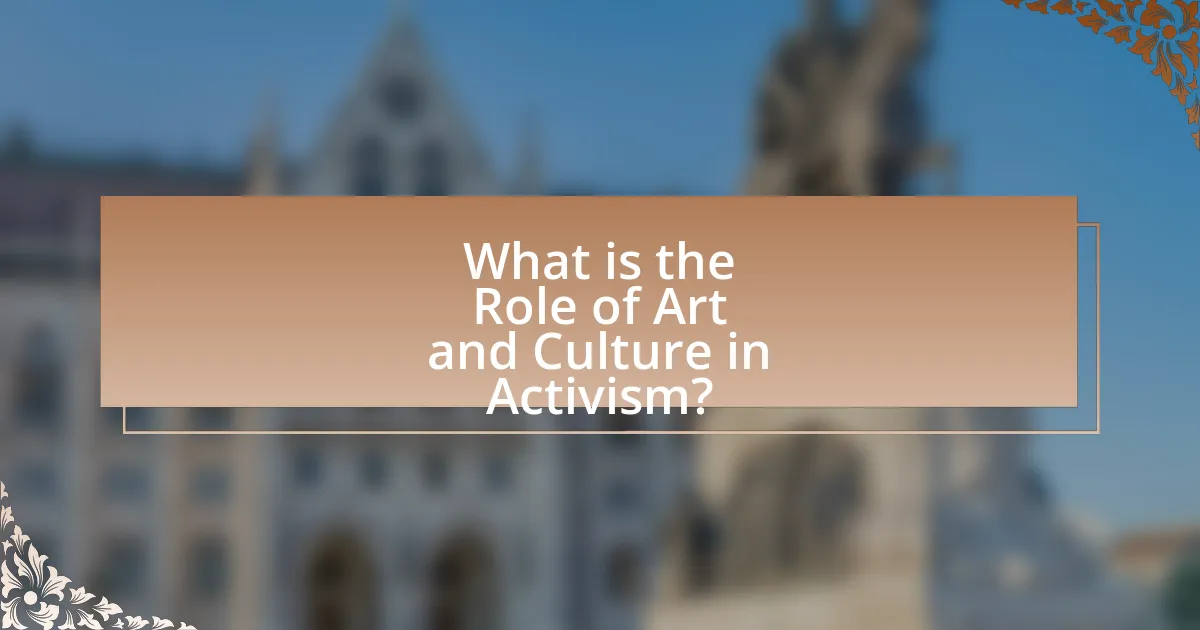
What is the Role of Art and Culture in Activism?
Art and culture play a crucial role in activism by serving as powerful tools for expression, communication, and mobilization. They enable activists to convey messages, evoke emotions, and foster community engagement, often transcending language barriers. Historical examples include the use of protest songs during the Civil Rights Movement, which galvanized support and raised awareness about racial injustices. Additionally, visual art, such as murals and installations, can create public dialogue and challenge societal norms, as seen in the works of artists like Banksy, who address political issues through provocative imagery. Overall, art and culture not only enhance the visibility of social movements but also inspire collective action and solidarity among diverse groups.
How do art and culture intersect with social movements?
Art and culture intersect with social movements by serving as powerful tools for expression, communication, and mobilization. Artistic works, such as music, visual art, and literature, often reflect the values, struggles, and aspirations of social movements, thereby raising awareness and fostering solidarity among participants. For instance, the Civil Rights Movement in the United States utilized music, such as protest songs, to unify activists and convey messages of resistance and hope. Additionally, visual art, like the murals of the Chicano Movement, played a crucial role in articulating cultural identity and political demands. These forms of artistic expression not only document social issues but also inspire action and provoke dialogue, making them integral to the fabric of social movements.
What historical examples illustrate this intersection?
Historical examples that illustrate the intersection of art, culture, and activism include the Harlem Renaissance, which showcased African American culture and advocated for civil rights through literature, music, and visual arts. This cultural movement, prominent in the 1920s, produced influential figures like Langston Hughes and Zora Neale Hurston, who used their art to challenge racial stereotypes and promote social change. Another significant example is the use of protest songs during the Vietnam War, where artists like Bob Dylan and Joan Baez created music that voiced opposition to the war and inspired activism. These instances demonstrate how art and culture have historically served as powerful tools for activism, influencing public opinion and mobilizing communities for social justice.
How do different cultures express activism through art?
Different cultures express activism through art by utilizing various mediums such as visual arts, music, dance, and literature to convey social and political messages. For instance, in Latin America, muralism has been a powerful tool for political expression, with artists like Diego Rivera using large-scale murals to address issues like class struggle and social injustice. In the United States, hip-hop culture has served as a platform for marginalized voices, with artists like Public Enemy addressing systemic racism and inequality through their lyrics. Similarly, Indigenous cultures often use traditional storytelling and visual art to highlight environmental issues and advocate for land rights. These artistic expressions not only raise awareness but also mobilize communities, as seen in the global impact of movements like Black Lives Matter, which has inspired a wave of artistic responses across various cultures.
Why is art considered a powerful tool for activism?
Art is considered a powerful tool for activism because it effectively communicates complex social issues and evokes emotional responses that can inspire action. Through various forms such as visual art, music, and performance, artists can convey messages that resonate with diverse audiences, making abstract concepts more relatable. Historical examples, such as the use of protest songs during the Civil Rights Movement, illustrate how art can mobilize communities and raise awareness about injustices. Additionally, art can transcend language barriers, allowing for a broader reach and impact in activism efforts.
What psychological effects does art have on audiences?
Art has significant psychological effects on audiences, including emotional engagement, cognitive stimulation, and social connection. Research indicates that exposure to art can evoke a wide range of emotions, from joy to sadness, influencing mood and mental well-being. For instance, a study published in the Journal of Positive Psychology found that engaging with art can lead to increased feelings of happiness and life satisfaction. Additionally, art stimulates cognitive processes by encouraging critical thinking and reflection, as evidenced by findings from the National Endowment for the Arts, which highlight how art education enhances problem-solving skills. Furthermore, art fosters social connections by creating shared experiences and dialogues among viewers, promoting empathy and understanding, as noted in studies by the American Psychological Association. These psychological effects underscore the powerful role art plays in shaping individual and collective experiences within the context of activism.
How does art facilitate communication of complex issues?
Art facilitates communication of complex issues by using visual, auditory, and performative elements to convey messages that may be difficult to articulate through traditional language. This multimodal approach allows artists to express nuanced perspectives and evoke emotional responses, making complex topics more accessible and relatable to diverse audiences. For instance, the use of powerful imagery in protest art can encapsulate social injustices, prompting viewers to engage with the underlying issues on a deeper level. Historical examples include Picasso’s “Guernica,” which powerfully communicates the horrors of war and its impact on humanity, effectively raising awareness about the Spanish Civil War. Such artistic expressions can transcend cultural and linguistic barriers, fostering dialogue and understanding around intricate societal challenges.
What are the various forms of artistic expression used in activism?
Various forms of artistic expression used in activism include visual art, music, theater, literature, and performance art. Visual art, such as murals and graffiti, often conveys powerful messages about social issues, exemplified by the street art movement that emerged in response to political unrest. Music serves as a rallying cry for movements, with songs like “Fight the Power” by Public Enemy becoming anthems for social justice. Theater and performance art engage audiences emotionally, as seen in productions like “The Vagina Monologues,” which addresses women’s rights. Literature, including poetry and essays, articulates activist ideas and experiences, with authors like Audre Lorde using their work to challenge societal norms. Each of these forms effectively communicates messages, mobilizes communities, and raises awareness about critical issues.
How do visual arts contribute to activist movements?
Visual arts contribute to activist movements by serving as powerful tools for communication and expression, enabling artists to convey messages that resonate with social and political issues. Through visual mediums such as paintings, murals, and installations, artists can raise awareness, provoke thought, and inspire action among audiences. For example, the mural movement in the 1970s in the United States, particularly in communities like San Francisco’s Mission District, utilized public art to address issues such as gentrification and civil rights, effectively mobilizing community members and fostering solidarity. Additionally, visual arts can create a shared cultural identity and a sense of belonging among activists, as seen in the use of imagery during the LGBTQ+ rights movement, where symbols like the rainbow flag became emblematic of the struggle for equality. Thus, visual arts not only enhance the visibility of activist causes but also play a crucial role in shaping public discourse and galvanizing collective action.
What role does performance art play in raising awareness?
Performance art plays a crucial role in raising awareness by engaging audiences emotionally and intellectually, often addressing social, political, and environmental issues. Through live performances, artists can create immersive experiences that provoke thought and inspire action, making complex topics more accessible. For instance, the work of artists like Marina Abramović has highlighted issues such as violence and identity, drawing significant public attention and sparking conversations. Additionally, studies have shown that performance art can effectively mobilize communities, as seen in events like the AIDS Memorial Quilt, which utilized performance to raise awareness about the AIDS crisis, demonstrating the medium’s power to foster empathy and drive social change.
How can art and culture mobilize communities for change?
Art and culture can mobilize communities for change by fostering collective identity and raising awareness about social issues. Through mediums such as visual arts, music, and performance, communities can express shared experiences and grievances, which can galvanize action. For instance, the use of murals in urban areas has historically served as a platform for social commentary, as seen in the Chicano murals of Los Angeles that addressed civil rights and cultural pride. Additionally, cultural events like festivals and exhibitions can create spaces for dialogue and collaboration, encouraging community members to engage in activism. Research indicates that participatory art projects can enhance civic engagement, as demonstrated by the “Art for Social Change” initiative, which showed increased community involvement in local governance following art-based interventions.
What challenges do artists face in activist movements?
Artists face several challenges in activist movements, including censorship, funding limitations, and the risk of alienation from mainstream audiences. Censorship can occur when governments or institutions suppress artistic expression that critiques social or political issues, limiting the artist’s ability to convey their message. Funding limitations often arise as artists may struggle to secure financial support for their projects, particularly when their work addresses controversial topics. Additionally, artists risk alienation from mainstream audiences who may not resonate with or support their activist messages, which can hinder their reach and impact. These challenges can significantly affect the effectiveness and sustainability of their contributions to social change.
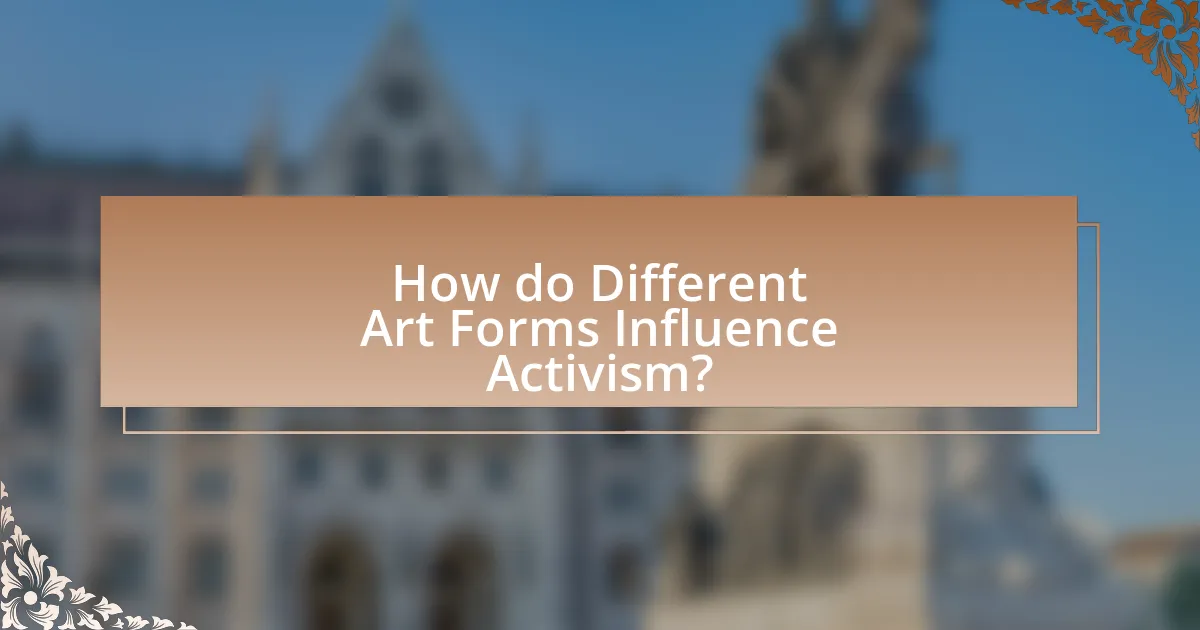
How do Different Art Forms Influence Activism?
Different art forms significantly influence activism by providing powerful means of expression, raising awareness, and mobilizing communities. Visual arts, such as graffiti and murals, can convey urgent social messages in public spaces, as seen in the works of artists like Banksy, who address issues like war and poverty. Music, through genres like protest songs, has historically united people and inspired movements, exemplified by songs like “We Shall Overcome” during the Civil Rights Movement. Theater and performance art engage audiences emotionally, prompting reflection and action, as demonstrated by the works of companies like The Living Theatre, which challenge societal norms. Literature, including poetry and essays, articulates the struggles and aspirations of marginalized groups, influencing public discourse and policy. Collectively, these art forms not only amplify activist voices but also foster solidarity and inspire change, as evidenced by the global impact of movements like Black Lives Matter, which utilize various artistic expressions to communicate their messages.
What impact does music have on social change?
Music significantly influences social change by serving as a powerful tool for expression, mobilization, and awareness. Throughout history, songs have been used to convey messages of resistance and solidarity, such as during the Civil Rights Movement in the United States, where artists like Sam Cooke and Bob Dylan created anthems that inspired activism and unity. Research indicates that music can enhance emotional engagement, making it easier for individuals to connect with social issues and motivate collective action. For instance, the song “We Shall Overcome” became synonymous with the struggle for civil rights, illustrating how music can encapsulate the spirit of a movement and galvanize support.
How have protest songs shaped public opinion?
Protest songs have significantly shaped public opinion by articulating social grievances and mobilizing collective action. These songs often resonate with listeners, creating a shared emotional experience that fosters solidarity among marginalized groups. For instance, during the Civil Rights Movement in the United States, songs like “We Shall Overcome” became anthems that not only expressed the struggle for equality but also galvanized support from broader audiences, influencing public sentiment and policy changes. Research indicates that music can enhance the retention of political messages, making protest songs an effective tool for raising awareness and inspiring activism.
What role do music festivals play in activism?
Music festivals serve as powerful platforms for activism by raising awareness about social issues and mobilizing communities for change. These events often feature performances and speeches that highlight causes such as climate change, racial equality, and mental health awareness. For instance, the Glastonbury Festival has a long history of promoting political activism, with its “Green Fields” area dedicated to environmental issues, showcasing organizations like Greenpeace. Additionally, festivals like Coachella have incorporated initiatives to support local charities and promote social justice, demonstrating their influence in fostering community engagement and activism.
How does literature contribute to activist discourse?
Literature contributes to activist discourse by providing a platform for marginalized voices and fostering empathy among readers. Through narratives, poetry, and essays, literature articulates social injustices and inspires collective action. For instance, works like “The Handmaid’s Tale” by Margaret Atwood highlight issues of gender oppression, prompting discussions on women’s rights. Additionally, literature can mobilize communities by creating shared experiences and understanding, as seen in the impact of “The Color Purple” by Alice Walker, which addresses racism and sexism. These literary contributions not only raise awareness but also serve as catalysts for social change, evidenced by the influence of authors like James Baldwin and Audre Lorde in civil rights movements.
What themes are commonly explored in activist literature?
Common themes explored in activist literature include social justice, environmentalism, human rights, and anti-oppression. These themes reflect the urgent issues that activists seek to address, such as systemic inequality, climate change, and the protection of marginalized communities. For instance, literature focused on social justice often critiques societal structures that perpetuate discrimination, while environmental activism highlights the need for sustainable practices to combat ecological degradation. Additionally, human rights literature emphasizes the importance of individual freedoms and the fight against authoritarianism, showcasing the struggles faced by oppressed groups. These themes are prevalent in works by authors like Audre Lorde, who addresses intersectionality, and Naomi Klein, who critiques corporate influence on environmental policy.
How do authors use storytelling to inspire action?
Authors use storytelling to inspire action by creating relatable characters and compelling narratives that evoke emotional responses. This technique engages readers, making them more likely to empathize with the characters’ struggles and motivations. For instance, narratives that highlight social injustices can mobilize audiences by illustrating the real-world implications of these issues, as seen in works like “The Hate U Give” by Angie Thomas, which addresses racial inequality and police violence. Research indicates that stories can enhance persuasion and motivate behavioral change, as demonstrated in studies published in the Journal of Personality and Social Psychology, which show that narratives can significantly influence attitudes and intentions.
What is the significance of visual arts in activism?
Visual arts play a crucial role in activism by effectively communicating messages, raising awareness, and inspiring action. Through visual mediums such as paintings, murals, and photography, artists can convey complex social issues in an accessible manner, making them resonate with a broader audience. For instance, the mural movement in the 1970s in the United States served as a powerful tool for marginalized communities to express their struggles and aspirations, significantly impacting public perception and policy. Additionally, studies have shown that visual art can evoke emotional responses, which can motivate individuals to engage in social change, as evidenced by the widespread use of art in protests and campaigns, such as the iconic “We the People” posters during the Women’s March in 2017.
How do murals and street art convey political messages?
Murals and street art convey political messages by using visual imagery and symbolism to express dissent, raise awareness, and inspire action. These forms of art often reflect social issues, historical events, or political movements, making complex ideas accessible to a broad audience. For example, the mural “The Great Wall of Los Angeles” illustrates the history of marginalized communities, highlighting systemic injustices. Additionally, street art like Banksy’s works often critiques government policies and societal norms, prompting public discourse. The immediacy and visibility of murals and street art allow them to engage viewers in real-time, fostering community dialogue and activism.
What role do galleries and exhibitions play in activism?
Galleries and exhibitions serve as vital platforms for activism by providing visibility to social issues and fostering dialogue among diverse audiences. They facilitate the presentation of artworks that challenge societal norms, raise awareness about injustices, and inspire collective action. For instance, the “Art for Social Change” initiative has demonstrated how exhibitions can mobilize communities around issues like climate change and racial equality, effectively engaging viewers in critical conversations. By showcasing artists who address these themes, galleries not only amplify marginalized voices but also encourage public participation in activism, thereby reinforcing the connection between art and social movements.
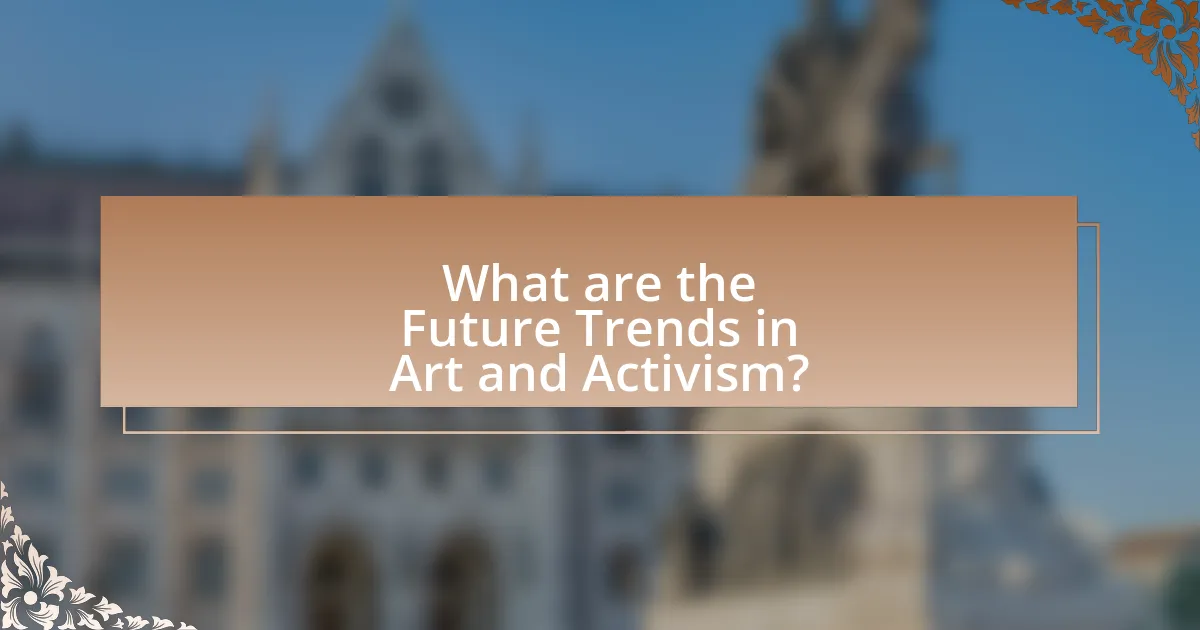
What are the Future Trends in Art and Activism?
Future trends in art and activism include the increasing integration of technology, particularly digital platforms and social media, to amplify voices and reach wider audiences. Artists are leveraging virtual reality, augmented reality, and interactive installations to create immersive experiences that engage the public in social issues. For instance, the rise of NFTs (non-fungible tokens) has allowed artists to monetize their work while supporting causes, as seen in campaigns that donate proceeds to social justice organizations. Additionally, collaborative projects between artists and activists are becoming more common, fostering community engagement and collective action. This trend is supported by the growing recognition of art as a powerful tool for social change, evidenced by movements like Black Lives Matter, where art has played a crucial role in visual storytelling and mobilization.
How is technology changing the landscape of activist art?
Technology is transforming activist art by enhancing accessibility, enabling global reach, and facilitating innovative forms of expression. Digital platforms allow artists to share their work widely, reaching audiences beyond geographical limitations. For instance, social media campaigns have amplified movements like Black Lives Matter, where visual art, such as memes and digital illustrations, quickly spread awareness and mobilized support. Additionally, tools like virtual reality and augmented reality create immersive experiences that engage viewers on a deeper emotional level, making the messages of activist art more impactful. The integration of technology in activist art not only democratizes the creation and distribution of art but also fosters collaboration among artists and activists worldwide, as seen in initiatives like the “Artivism” movement, which merges art with social justice efforts.
What role do social media platforms play in promoting activist art?
Social media platforms play a crucial role in promoting activist art by providing a global stage for artists to share their work and messages. These platforms enable artists to reach diverse audiences quickly, facilitating the spread of awareness about social issues through visual storytelling. For instance, the hashtag #BlackLivesMatter has been instrumental in amplifying artwork that addresses racial injustice, leading to increased visibility and engagement with activist art. Additionally, studies show that social media campaigns can significantly enhance the reach of activist art, with platforms like Instagram and Twitter allowing for rapid sharing and interaction, thus fostering community support and dialogue around critical issues.
How are digital art forms being used for social justice?
Digital art forms are being used for social justice by amplifying marginalized voices and raising awareness about social issues through accessible and engaging mediums. For instance, platforms like social media allow artists to share their work widely, reaching diverse audiences and fostering community engagement. Notable examples include the use of digital illustrations and animations to depict police brutality, which have gone viral and sparked global movements such as Black Lives Matter. Additionally, interactive digital installations and virtual reality experiences have been employed to immerse viewers in the realities faced by oppressed communities, effectively humanizing complex social issues. These methods not only educate the public but also mobilize support for various causes, demonstrating the powerful intersection of art and activism in the digital age.
What emerging movements are shaping the future of art in activism?
Emerging movements shaping the future of art in activism include digital activism, eco-art, and social practice art. Digital activism leverages technology and social media to amplify voices and mobilize communities, exemplified by campaigns like #BlackLivesMatter, which utilize visual art and graphics to convey powerful messages. Eco-art focuses on environmental issues, with artists like Olafur Eliasson creating installations that raise awareness about climate change and sustainability. Social practice art emphasizes community engagement, where artists collaborate with local populations to address social issues, as seen in projects by Theaster Gates that transform urban spaces through art and community involvement. These movements reflect a shift towards inclusivity, interactivity, and a focus on pressing global challenges, demonstrating the evolving role of art in activism.
How are youth-led movements influencing artistic expression?
Youth-led movements are significantly influencing artistic expression by promoting themes of social justice, identity, and activism through various art forms. These movements, such as Black Lives Matter and Fridays for Future, utilize art as a medium to convey powerful messages, engage communities, and inspire action. For instance, murals and street art created during protests serve as visual representations of collective struggles and aspirations, making art a tool for both personal and political expression. Research indicates that youth engagement in artistic activism fosters a sense of agency and encourages innovative approaches to addressing societal issues, as seen in the rise of digital art and social media campaigns that amplify their voices globally.
What global trends are impacting local activist art scenes?
Global trends impacting local activist art scenes include the rise of digital technology, increased globalization, and heightened social awareness. Digital technology enables artists to reach wider audiences through social media and online platforms, facilitating the rapid dissemination of activist messages. Globalization fosters cross-cultural exchanges, allowing local artists to draw inspiration from international movements and collaborate with global networks. Additionally, heightened social awareness around issues such as climate change, racial justice, and gender equality drives local artists to engage with these themes, reflecting and amplifying community concerns. For instance, the Black Lives Matter movement has inspired numerous local art initiatives worldwide, demonstrating how global issues can resonate within specific cultural contexts.
What practical strategies can artists use to enhance their activism?
Artists can enhance their activism by utilizing social media platforms to amplify their messages and engage with a broader audience. By sharing their work and perspectives online, artists can reach diverse communities and foster discussions around social issues. For instance, the #BlackLivesMatter movement saw artists using platforms like Instagram to share powerful visuals and narratives that raised awareness and mobilized support. Additionally, collaborating with grassroots organizations allows artists to align their creative efforts with established activist initiatives, thereby increasing the impact of their work. Research from the National Endowment for the Arts indicates that art can effectively influence public opinion and inspire action, demonstrating the potential of artistic engagement in activism.
